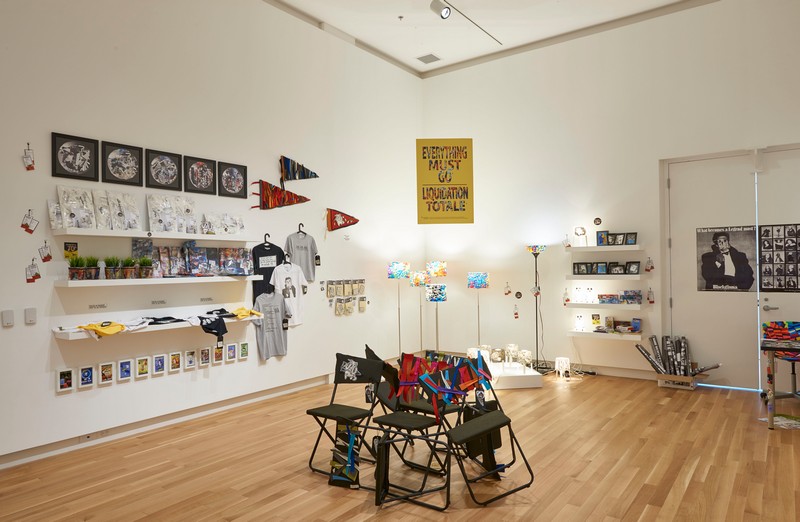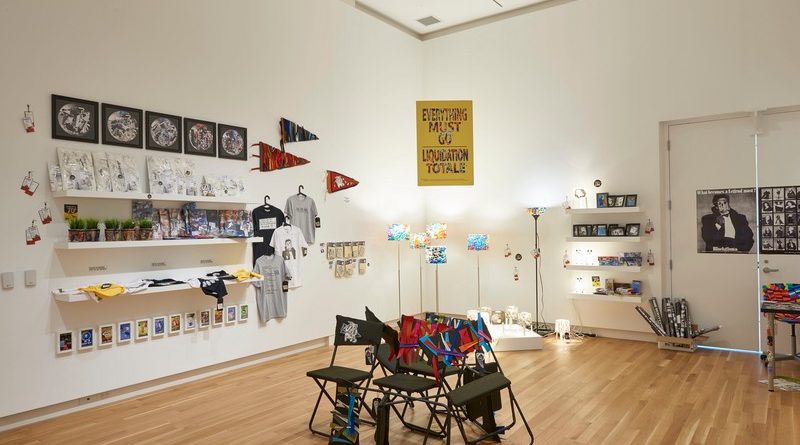Everything must go / Liquidation totale – Michèle Provost
Maureen Korp

Photo André Rozon
“Everything must go / Liquidation totale,” artist Michèle Provost’s solo exhibition at the Ottawa Art Gallery is a tour de force. The artist’s installation tells a wry, multi-layered story of compassion using everyday domestic items, leftovers no one wants when someone dies, the stuff donated to charity or left behind in the dumpster. Provost’s medium is assemblage, painting, drawing, and the textile arts.
Physically, the format of the artist’s installation references a second-hand shop. In one room are piles of chairs, groups of lamps, walls festooned with t-shirts, and shelving stacked with bed sheets, books, block prints, posters, and more; the second room displays larger household furnishings.
Look closely. Read all the labels.
The stories suggested are both anonymous, and specific. The narratives might be anyone’s story. They are also interrelated particular memories of an artist who may have outlived his fame.
Look at the silk-screened t-shirts hanging on the wall—two grey, one white, one black. All bear the label: “no name no face.” One t-shirt even declares its wearer will be “obedient to all demands—will not cry in public.”
The bed sheets, “liquidation 70%, plus take 20%,” are brightly coloured, each well wrapped in plastic. Labelled “Pavane,” they are sheets intended for double or queen-sized beds, flat or fitted. Keep in mind, too, the pavane was once an elegant social dance performed by aristocrats. No need to tell all the stories. A gentleman is discreet. The bed in the other room is a single. Black-and-white “Rideau curtains” are a steal at 50% off. Everything is for sale. Everything must go.
Two large black-and-white posters reference a 1960s advertising campaign for Blackgama mink coats: “What becomes a legend most?” Celebrities of that era wore mink coats proudly. The gallery’s posters give us head shots of Andy Warhol, Sophia Loren, Marilyn Monroe, among others, and, yes, one “crying artist.”
Ten table lamps come with scattered instructions for presenting oneself as a “crying artist.” Another t-shirt declares: “Riopelle gives you wiiings.” Is this…? Could it be…? Quebec’s Jean-Paul Riopelle? Our suspicions are confirmed when we see the almost forgotten imagery of blue Gauloises and Ricard cigarette packages, framed and piled on another shelf in the gallery.
Jean-Paul Riopelle (1923-2002) of Montreal, a founding member of the Automatistes, was a mid-century sensation in the international art world. He lived in Paris much of his life before relocating back to Quebec. Today, his work and name are not as well-known as others of that time—eg, Jackson Pollock (1912-1956), Alberto Giacometti (1901-1966), Marc Chagall (1887-1985). Why is that? Does it matter?
Several small framed drawings from graphic novels provide unattributed quotations to ponder. Some may be Riopelle’s own words: “If I paint, it’s because I don’t know how to do anything else.” Others may be comments by contemporary critics, or art historians: “Sales, however, continue to be rare;” and, “Unfortunately, self-imposed rural isolation limited the influence of his last works.” The graphic novels are priced at 30% and 50%, and are marked “for mature readers.”
Take time to look closely at the items the artist has piled into these rooms. Read all the labels. The questions Michèle Provost frames with “Everything must go/ Liquidation totale” are ones that matter, questions arising from our own lives, too. No matter. In the end, alas, everything must go.
Ottawa Art Gallery
50 Mackenzie King Bridge, Ottawa
October 11, 2018–March 10, 2019

Photo André Rozon
